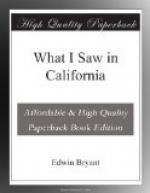The next morning (Nov. 19), the river being too high to ford, we constructed, by the aid of the Indians, tule-boats, upon which our baggage was ferried over the stream. The tule-boat consists of bundles of tule firmly hound together with willow withes. When completed, in shape it is not unlike a small keel-boat. The buoyancy of one of these craft is surprising. Six men, as many as could sit upon the deck, were passed over, in the largest of our three boats, at a time. The boats were towed backwards and forwards by Indian swimmers—one at the bow, and one at the stern as steersman, and two on each side as propellers. The poor fellows, when they came out of the cold water, trembled as if attacked with an ague. We encamped near the house of Mr. Livermore (previously described), where, after considerable difficulty, I obtained sufficient beef for supper, Mr. L. being absent. Most of the Indians did not get into camp until a late hour of the night, and some of them not until morning. They complained very much of sore feet, and wanted horses to ride, which I promised them as soon as they reached the Pueblo de San Jose.
About ten o’clock on the morning of the 20th, we slaughtered a beef in the hills between Mr. Livermore’s and the mission of San Jose; and, leaving the hungry party to regale themselves upon it and then follow on, I proceeded immediately to the Pueblo de San Jose to make further arrangements, reaching that place just after sunset. On the 21st I procured clothing for the Indians, which, when they arrived with Mr. Jacob in the afternoon, was distributed among them.
On my arrival at the Pueblo, I found the American population there much excited by intelligence just received of the capture on the 15th, between Monterey and the mission of San Juan, of Thos. O. Larkin, Esq., late U.S. Consul in California, by a party of Californians, and of an engagement between the same Californians and a party of Americans escorting a caballada of 400 horses to Colonel Fremont’s camp in Monterey. In this affair three Americans were killed, viz.: Capt. Burroughs, Capt. Foster, and Mr. Eames, late of St. Louis, Mo. The mission of San Juan lies on the road between the Pueblo de San Jose and Monterey, about fifty miles from the former place, and thirty from the latter. The skirmish took place ten miles south of San Juan, near the Monterey road. I extract the following account of this affair from a journal of his captivity published by Mr. Larkin:—




